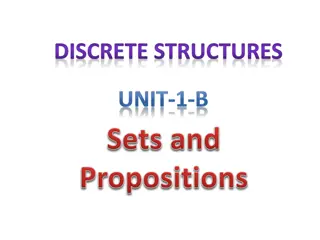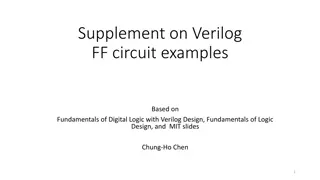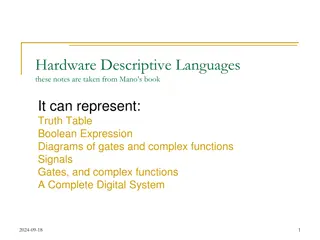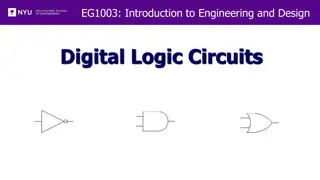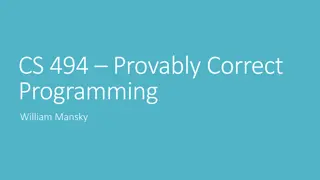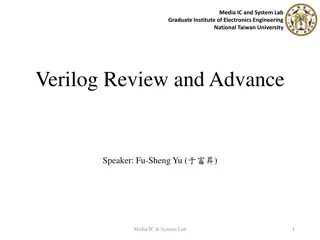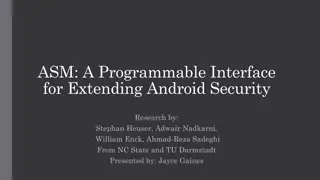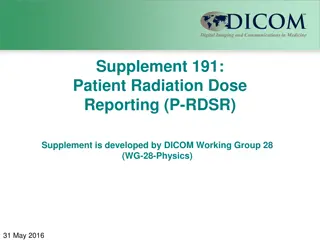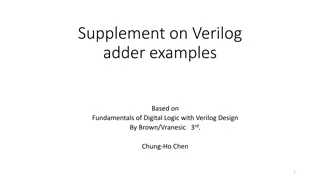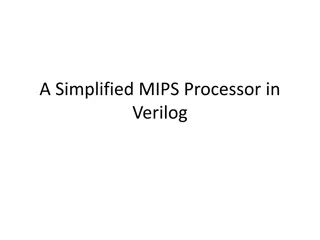
Verilog Algorithm State Machine Chart Supplement
Explore a supplement on implementing a bit counter in Verilog using algorithm state machine charts. Learn how to count the number of 1s in a binary sequence and store the count in Verilog. Dive into the ASM chart, datapath design, and Verilog module for this project.
Download Presentation

Please find below an Image/Link to download the presentation.
The content on the website is provided AS IS for your information and personal use only. It may not be sold, licensed, or shared on other websites without obtaining consent from the author. If you encounter any issues during the download, it is possible that the publisher has removed the file from their server.
You are allowed to download the files provided on this website for personal or commercial use, subject to the condition that they are used lawfully. All files are the property of their respective owners.
The content on the website is provided AS IS for your information and personal use only. It may not be sold, licensed, or shared on other websites without obtaining consent from the author.
E N D
Presentation Transcript
Supplement on Verilog for Algorithm State Machine Chart Based on Fundamentals of Digital Logic with Verilog Design and Fundamental of Logic Design Chung-Ho Chen 1
Problem: Bit Counter Count the number of 1s in A And store the number of 1s in B B = 0 ; while A 0 do if a 0= 1 then B = B + 1 ; end if; Right-shift A ; end while; 2
ASM Chart for Bit Counter Reset S1 Initialize B B 0 Load A S2 S1 Start another ? B = 0 ; while A 0 do if a 0= 1 then 0 0 1 s s s=1, start counting 1 B = B + 1 ; end if; Right-shift A ; end while; Load B Shift A Update B (a0=1) S2 S3 Shift right A Done 1 A = 0 ? B B + 1 Conditional output S2 which performs the shift is actually shifted at the next clock edge, so the checking of A, and a0 are performed before the shift of A. 0 0 a 0 1 3
Datapath for the bit counter If n = 8, need how many bits? A shift register A counter register Need to test if a0=1 Need test if A=0? Need load/enable signals +1 +1 A <> 0? 4
module bitcount (Clock, Resetn, LA, s, Data, B, Done); input Clock, Resetn, LA, s; input [7:0] Data; output reg [3:0] B; output reg Done; wire [7:0] A; wire z; reg [1:0] Y, y; reg EA, EB, LB; // control circuit parameter S1 = 2'b00, S2 = 2'b01, S3 = 2'b10; always @(s, y, z) begin: State_table case (y) S1: if (!s) Y = S1; else Y = S2; S2: if (z == 0) Y = S2; else Y = S3; S3: if (s) Y = S3; else Y = S1; default: Y = 2'bxx; endcase end always @(posedge Clock, negedge Resetn) begin: State_flipflops if (Resetn = = 0) y <= S1; else y <= Y; end continued in Part b. ASM Chart for Bit Counter to Verilog Code Reset S1 LB B 0 Load A Start another ? 0 0 1 y: PS Y: NS s s s=1, start counting 1 S2 S3 EA Shift right A Done 1 A = 0 ? B B + 1 Conditional output Z 0 EB 0 a 0 1 5
always @(y, A[0]) begin: FSM_outputs // Control data path // defaults EA = 0; LB = 0; EB = 0; Done = 0; case (y) S1: LB = 1; S2: begin ASM Chart for Bit Counter to Verilog Code Reset S1 EA = 1; if (A[0]) EB = 1; else EB = 0; Outputs in a state LB B 0 Load A Start another ? end Done = 1; 0 S3: 0 1 endcase s s end s=1, start counting 1 // datapath circuit S2 S3 // counter B always @(negedge Resetn, posedge Clock) if (!Resetn) B <= 0; else if (LB) B <= 0; else if (EB) B <= B + 1; EA Shift right A Done 1 A = 0 ? B B + 1 Conditional output Z 0 EB 0 shiftrne ShiftA(Data, LA, EA, 0, Clock, A); assign z = ~| A; // reduction NOR. a 0 1 endmodule 6
module shiftrne (R, L, E, w, Clock, Q); parameter n = 4; input [n-1:0] R; input L, E, w, Clock; output reg [n-1:0] Q; integer k; Shift Right Register always @(posedge Clock) begin if (L) Q <= R; else if (E) begin Q[n-1] <= w; for (k = n-2; k >= 0; k = k-1) Q[k] <= Q[k+1]; end end endmodule 7




